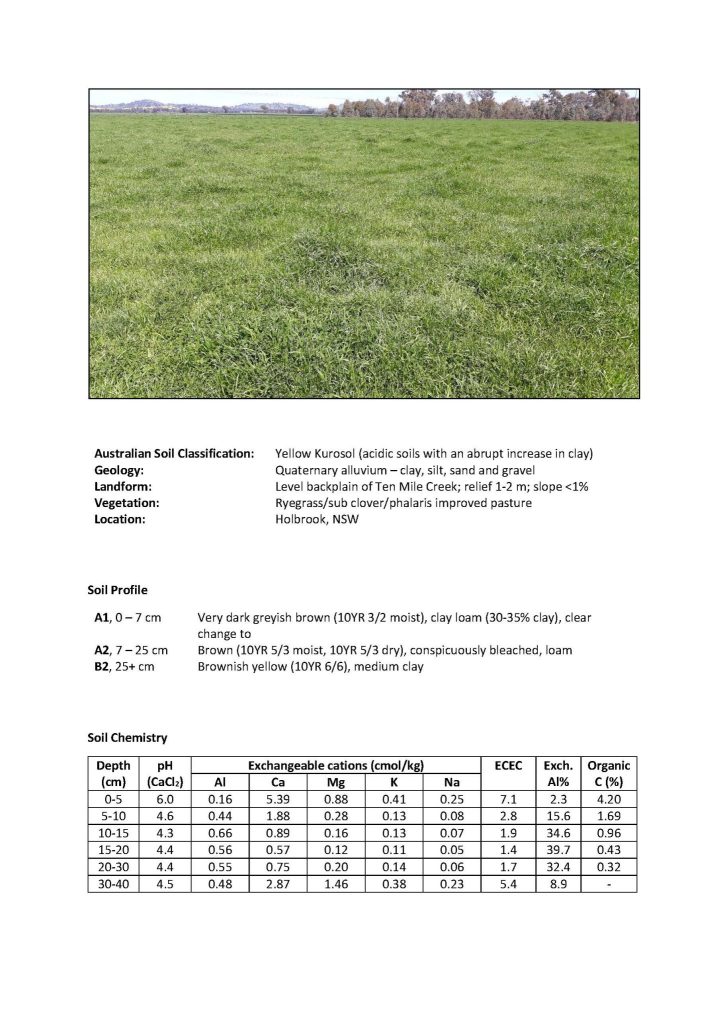The landscape of the Holbrook region broadly consists of undulating hills of Ordovician metasedimentary rocks and Silurian granites in the east, and flat to gently undulating alluvial floodplains of the Billabong Creek and its tributaries in the west. Major soil types are Kurosols (strongly acid duplex soils), Chromosols (duplex soils), Kandosols (structureless soils) and Dermosols (structured soils) on the slopes; Sodosols (sodic duplex soils) in the drainage depressions and on the older alluvium of Billabong Creek; and Chromosols and Dermosols on the more recent alluvium. Swamps and minor areas of gilgai on the floodplain consists of Grey Vertosols (cracking clays). More information can be found in the Soil Landscapes of the Holbrook-Tallangatta 1:100 000 Sheet report and map.
The major soil constraint affecting productivity in pasture and cropping systems in our region is acidity, in particular subsurface acidity. Over the years, Holbrook Landcare has partnered with various research organisations and farming system groups on research projects looking at ways to address soil acidity in our region. For over 10 years we have also run a soil testing program for farmers and we actively use this data to monitor the trends in soil properties over time. See our ‘Soils Program’ below for more information on our current and past projects.
Read HLN’s Acid Soil Management Strategy here.
An In Depth Look at Our Soils...
Yellow Kurosol
Landform: Level backplain of Ten Mile Creek; relief 1-2m; slope <1%
Vegetation: Ryegrass/sub clover/phalaris improved pasture

Red Kurosol
Geology
Landform: Gently undulating plain, mid slope; relief 1-3 m; slope 1-2%
Vegetation: Phalaris/sub clover/ryegrass improved pasture

Brown-Orthic Tenesol
Geology
Landform: Undulating rises, mid slope; relief 10-20 m; slope 10%
Vegetation: Mixed native and introduced grasses

Brown Kurosol
Geology
Landform: Gently undulating plain, lower slope; relief 2-5 m; slope 1-3%
Vegetation: Ryegrass/sub clover/phalaris improved pasture

Acid Soils Projects
Soil Quality Page
HLN Acid Soils Strategy

2022 Producer Support Strategy
Acid soils are common in high rainfall, productive soils throughout south-eastern Australia. Subsurface (5–20cm) soil acidity particularly is often undetected by traditional soil testing methods and ineffectively treated by traditional “rule of thumb” liming techniques.
New research has identified that a mind-shift is needed across Industry in the detection and treatment of soil acidity.
Holbrook Landcare Network (HLN) aims to help producers understand the problem of soil acidity and its productive, environmental and economic impact on their farming systems. HLN also aims to assist landholders to effectively monitor and manage acid soils on farm using the latest science.
Current Projects to Support this Strategy
Tackling Soil Acidity – In collaboration with NSW DPI, the Morven trial site aims to investigate the impact of liming rates and incorporation methods to ameliorate subsurface acidity in local soils. HLN has established 32 long-term monitoring sites to monitor soil acidification. Funded by the National Landcare Program and Grassland Society of NSW.
MLA PDS – Managing soil acidity in permanent pastures – investigating liming techniques in existing perennial pastures at Holbrook, Rosewood and Mannus, NSW through farmer-led producer demonstration sites. Funded by MLA.
FutureSOILS – In partnership with NSW DPI, ANU, FarmLink, Central West Farming Systems and Incitec Pivot. Developing a decision-support tool that predicts changes in pH down the soil profile. Investigating farm management scenarios through advanced machine learning, validated via a farm-scale trial site at Burrumbuttock, NSW. Funded by the National Landcare Program.
Soil Innovation Accelerator Program – Building a more efficient/economic soil sampling process for farmers. Funded by the Soil CRC.

Key Priority Areas For 2022
Improving soil sampling and testing services for better decision making on farm. Developing a whole-of-service strategy for soil testing that will include improved sampling techniques and data visualisation to match decision-making needs.
Strategies for liming in pasture systems. Establishing local best management practices for top-dressed lime applications in permanent pastures.
Impact of liming on pasture yield and composition, soil biology and soil carbon.
Economic impact of soil sampling and lime application techniques on farm systems.

Become a Member and Contribute to Effective Acid Soil Management
Membership to HLN gives you:
- Access to our soil testing services including the opportunity to receive any discounts offered.
- Current and scientifically backed soil management advice via our website and publications.
- Invitations to attend all field days, workshops and presentations from highly regarded guest speakers.









